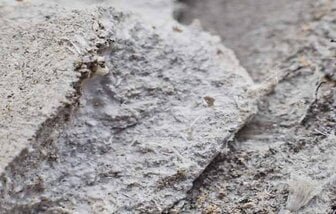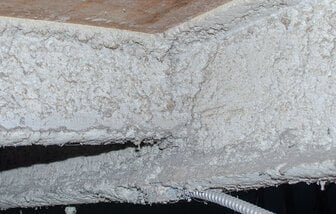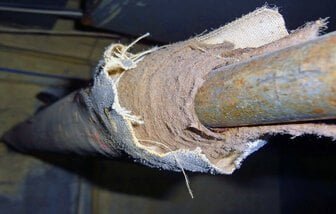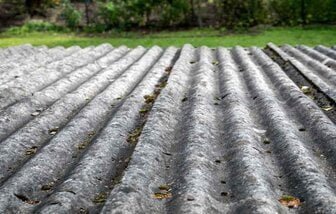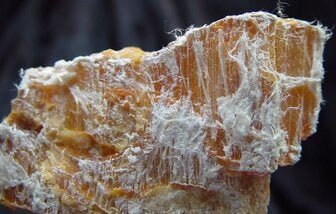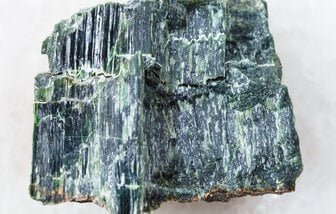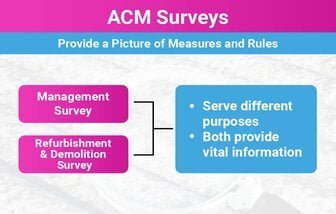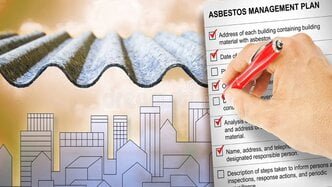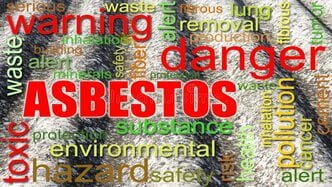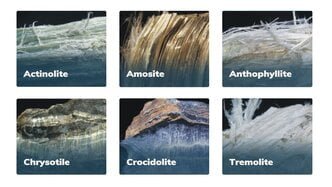Understanding Chrysotile Asbestos: Identification, Risks, and Safe Removal in the UK
Learn about chrysotile asbestos, also known as white asbestos, its uses in the UK, and how to identify it. Understand the health risks associated with asbestos exposure, including asbestosis, lung cancer, and mesothelioma. Discover safe removal practices and regulations under the Control of Asbestos Regulations 2012 to ensure proper management and disposal of asbestos-containing materials.
What is Chrysotile Asbestos and How to Identify It?
Chrysotile asbestos, often referred to as white asbestos, is a naturally occurring fibrous mineral from the serpentine group. Its chemical composition is primarily magnesium silicate, which contributes to its distinctive durable and heat-resistant properties.
Historically, this made chrysotile asbestos highly sought after for various industrial and construction applications. The mineral’s flexibility, combined with its resistance to heat, electricity, and chemical damage, positioned it as an ideal material for a wide array of products.
During the 20th century, chrysotile asbestos was extensively used in the UK across multiple industries. Common applications included roofing materials, cement products, insulation, brake linings, and even textiles.
Its ubiquity in construction meant that many buildings erected before the 1980s are likely to contain chrysotile asbestos in some form. The material’s prevalence was driven by its affordability and exceptional performance in enhancing the durability and safety of various products.
Identifying chrysotile asbestos requires a keen eye for its distinctive physical characteristics. Typically, this form of asbestos appears white and fibrous, with a silky texture that can be observed under a microscope.
It is most commonly found in products such as corrugated roofing sheets, cement pipes, vinyl floor tiles, and insulating boards. In buildings, chrysotile asbestos can be located in areas such as roofs, walls, ceilings, and even around pipes and boilers.
For those attempting to identify chrysotile asbestos in situ, visual inspection might not always suffice due to its integration into other materials. However, some telltale signs include fraying or fibrous edges on older insulation or roofing materials.
When in doubt, it is crucial to consult with a certified asbestos professional who can conduct thorough testing and provide accurate identification. Visual aids, such as photos of common products containing chrysotile, can further assist individuals in recognizing this hazardous material and taking appropriate safety measures.
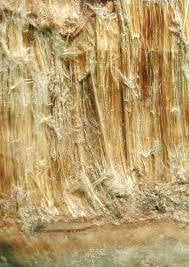
Chrysotile asbestos is made up of long, flexible fibers that can be easily woven into fabrics or mixed with other materials to create asbestos-containing products (ACPs). Its unique properties made it a popular choice in numerous applications, including:
- Building materials: Chrysotile asbestos was commonly used in the construction industry for its fire-resistant properties. It was often found in insulation, roofing materials, and cement products.
- Automotive industry: Asbestos was utilized in the manufacturing of brake pads, clutch facings, and gaskets due to its heat resistance and friction properties.
- Textiles: Chrysotile asbestos was incorporated into fabrics, such as protective clothing and thermal insulating materials, to provide additional strength and heat resistance.
- Fireproofing: It was used as a fireproofing material in various settings, including ships, aircraft, and industrial buildings.
Exposure to chrysotile asbestos can pose serious health risks. When the fibers are inhaled or ingested, they can become trapped in the lungs or other organs, leading to various health conditions. The main health risks associated with chrysotile asbestos exposure include:
1. Asbestosis
Asbestosis is a chronic lung disease caused by the inhalation of asbestos fibers. It results in the scarring of lung tissue, leading to breathing difficulties and reduced lung function.
2. Mesothelioma
Mesothelioma is a rare and aggressive form of cancer that primarily affects the lining of the lungs, but can also affect other organs. It is strongly linked to asbestos exposure, including chrysotile asbestos.
3. Lung Cancer
Exposure to chrysotile asbestos increases the risk of developing lung cancer. Smokers who are also exposed to asbestos have a significantly higher risk of developing lung cancer compared to non-smokers.
4. Other Respiratory Diseases
Chrysotile asbestos exposure has also been associated with other respiratory conditions, such as pleural plaques, pleural thickening, and chronic obstructive pulmonary disease (COPD).
Due to the recognized health hazards, many countries have implemented regulations and bans on the use of chrysotile asbestos. The World Health Organization (WHO) and other health agencies have classified all forms of asbestos, including chrysotile, as carcinogenic to humans.
Several countries have completely banned the use, import, and export of asbestos-containing products, while others have imposed strict regulations to minimize exposure and ensure safe handling and disposal of asbestos materials.
If you suspect the presence of chrysotile asbestos in your home or workplace, it is crucial to consult with professionals who specialize in asbestos testing and removal. Attempting to handle or remove asbestos-containing materials without proper training and equipment can release harmful fibers into the air, increasing the risk of exposure.
Qualified asbestos abatement contractors follow strict protocols to safely remove and dispose of asbestos materials, minimizing the potential health risks for both workers and occupants.
Chrysotile asbestos, also known as white asbestos, poses significant health risks due to its fibrous nature. When these fibers become airborne and are inhaled, they can lead to severe respiratory diseases. Among the most serious conditions linked to asbestos exposure are asbestosis, lung cancer, and mesothelioma. Asbestosis is a chronic lung disease caused by the accumulation of asbestos fibers in the lungs, leading to scarring and impaired lung function. Lung cancer from asbestos exposure is particularly insidious, as it may take decades to develop, often manifesting long after initial exposure.
Mesothelioma, a rare and aggressive cancer affecting the lining of the lungs, abdomen, or heart, is almost exclusively linked to asbestos exposure. The latency period for these diseases can be exceedingly long, sometimes spanning 20 to 50 years. This delay in symptom onset underscores the long-term health implications of asbestos exposure, making early identification and management critical.
In the UK, the Control of Asbestos Regulations 2012 provides a comprehensive framework for the safe management and removal of asbestos. These regulations mandate rigorous procedures to prevent exposure, including the requirement for asbestos surveys and risk assessments in buildings where asbestos presence is suspected. Conducting these surveys helps in identifying asbestos-containing materials (ACMs) and assessing the risk they pose.
Safe removal of chrysotile asbestos involves several critical steps. Firstly, it is essential to hire licensed asbestos removal professionals who are trained in handling and disposing of asbestos safely. These professionals will use protective gear, such as respirators and disposable coveralls, to minimize exposure. The removal process typically involves sealing off the work area, using negative pressure units to prevent the spread of fibers, and meticulously wetting the asbestos material to reduce dust.
Once removed, asbestos waste must be securely bagged and labeled for proper disposal at designated facilities. Following these stringent guidelines ensures that the removal process is conducted safely, protecting both the workers and the general public from the hazards associated with asbestos exposure. Adhering to these practices is not only a legal requirement but also a critical measure in safeguarding public health.
Asbestos Millboard
Millboards manufactured between 1896 and 1965 can contain chrysotile asbestos (up to 97%). Often found in: Pipe runs, electrical gear, vaults, storage. Often used for: Fire protection on structural
Asbestos Cement
Generally containing 10-15% asbestos fibres which are bound in Portland cement or calcium silicate. Uncoated sheets, widely used in the past as a building material can be identified as light grey in
Asbestos Sprayed Coatings
Asbestos sprayed coatings have been widely used in the construction industry in the past, particularly in the United Kingdom
Asbestos Tiles
Learn about asbestos floor tiles in the UK, including their identification, dangers, and management. Find out how to identify asbestos floor tiles
Asbestos Lagging, Ropes & Yarns
Asbestos lagging and ropes were once widely used for their insulation properties. However, due to the health risks associated with asbestos exposure, their use has been banned in many countries.
Asbestos Textured Coatings
Asbestos textured coatings, also known as Artex or similar products, were widely used in the construction industry in the UK from the 1960s to the 1990s. These coatings were applied to ceilings
Corrugated Asbestos Panels
When it comes to garage roofing in the UK, one type of material that was widely used in the past is corrugated asbestos panels. However ue to health and safety concerns, the use of asbestos has been banned
Crocidolite Asbestos
Learn about crocidolite asbestos, a highly hazardous form of asbestos that was widely used in various industries. Discover its properties, health risks, and the importance of professional testing and removal.
Amosite Asbestos
Amosite asbestos, also known as brown asbestos, is a type of asbestos mineral that was widely used in various industries for its heat resistance and insulating properties.
Chrysotile Asbestos
Learn about chrysotile asbestos, its applications, and the potential health risks associated with exposure. Understand the importance of safety measures and regulations to prevent asbestos
Asbestos Surveys
We are able to provide any level of survey required, up to the Demolition and Refurbishment survey now required prior to the demolition of any building or structure.
What is Asbestos?
Asbestos was commonly used as a construction material in the UK between the 1950s and 1980s in particular. If your home was built between these years, chances are that you are living with Asbestos
Asbestos Management Plan
An asbestos management plan is essential for managing asbestos-containing materials (ACMs) in buildings. It aims to protect occupants and workers from asbestos exposure through identification, assessment, and control of ACMs.
Asbestos Dangers
Learn about the dangers of asbestos, its health risks including mesothelioma and lung cancer, and how to protect yourself from exposure. Understand the regulations and laws regarding asbestos, and find resources and support for asbestos-related issues.
Types Of Asbestos
Learn about the different types of asbestos, including chrysotile asbestos, amphibole asbestos, tremolite asbestos, and anthophyllite asbestos. Understand the characteristics and health risks associated with each type of asbestos.
How To Manage Asbestos
Dealing with asbestos requires caution and adherence to proper safety procedures. Identifying asbestos and taking appropriate action is crucial to protect the health and well-being of individuals. If you suspect the presence of asbestos.
Ready to start your project?
Committed to Excellence on all levels
Let's Work Together
Please complete the form below and someone from the Total team will be in touch to discuss your asbestos requirements For urgent needs, our customer support team is available through various channels. You can reach us via phone during business hours, or through our dedicated email support. We are committed to providing timely assistance and ensuring your asbestos concerns are addressed promptly and professionally.


